How to spot ‘Santa’ in the sky tomorrow: International Space Station will be visible to the naked eye as it passes over the UK on Christmas Eve
With Christmas just two days away, children all over the world will be eagerly keeping their eyes to the sky in the hope of seeing Santa on his travels.
Parents will be pleased to hear that 'Santa' – in the shape of the International Space Station (ISS) – will be visible from the UK on Christmas Eve this year.
NASA says the spacecraft will be “the third brightest object in the sky and is easy to spot if you know when to look for it.”
Although he is not the man in red, the International Space Station will be a good alternative for both big and small children who will be interested in him.
“Visible to the naked eye, the space station looks like a fast-moving plane, flying at a much higher altitude, traveling at thousands of miles per hour!” NASA said.
For parents who want to surprise their children with a festive surprise, the passage of the International Space Station could make a quite compelling alternative to Santa's sleigh
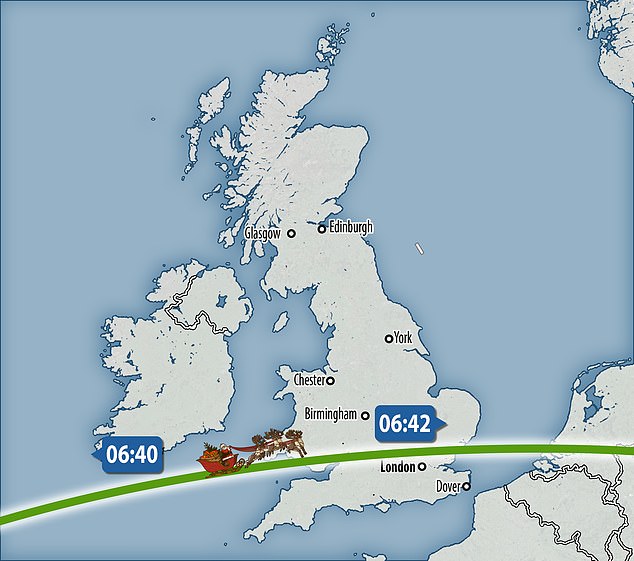
The International Space Station (also known as Santa) will have a very clear pass over the UK on Christmas Eve and will be clearly visible in the sky just before dawn
| date and time | Visible | Maximum height | It seems | Disappears |
|---|---|---|---|---|
| December 23, 5:55 AM | 4 minutes | 65 degrees | 52° above the southwest | 10° above E |
| December 24, 5:10 AM | 2 minutes | 27 degrees | 27 degrees above east | 10° above E |
| December 24, 6:42 AM | 6 minutes | 86 degrees | 18° above the west | 10° above E |
| December 25, 5:56 AM | 4 minutes | 89 degrees | 68° above the west | 10° above E |
| December 26, 5:11 AM | 2 minutes | 26 degrees | 26° above E | 10° above E |
| December 26, 6:44 AM | 6 minutes | 89 degrees | 21° above the west | 10° above E |
| December 27, 5:57 AM | 4 minutes | 86 degrees | 68° above the WNW | 10° above E |
| December 28, 5:11 AM | 2 minutes | 26 degrees | 26° above E | 10° above E |
| December 28, 6:44 AM | 5 minutes | 66 degrees | 21° above the west | 10° over eastern Europe |
The International Space Station will make two passes to the UK in the early morning of Christmas Eve.
The space station will make its brief debut at 5:10 a.m. GMT Sunday morning and will be visible for about two minutes.
To see the first pass, look east at 27 degrees above the horizon.
For reference, a fist extended at arm's length is usually about 10 degrees, so you can use this as a guide to help find the starting point of the ISS.
It will then appear again at 6:42 AM GMT where it will be visible for a full six minutes.
This time the ISS will appear at an angle of 18 degrees above the west and will follow a long arc until it disappears in the east.
As well as being a little easier to get up, this second corridor will also provide a better view of the station as it should be higher than most buildings.
If you wake up early on Christmas Day, or are just coming home from a great Christmas Eve party, there will be another chance to spot the International Space Station the next day.
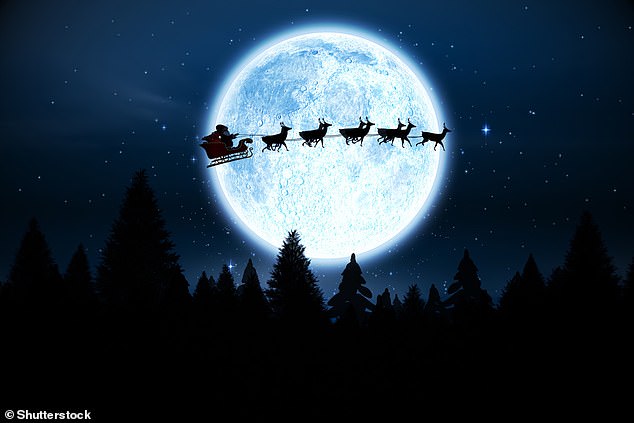
To keep the magic of Santa alive this year, watch the bright light of the International Space Station as it passes overhead
You'll be able to see “Santa heading back to the North Pole” at 5:56 a.m. GMT for four minutes.
To see this festive celebration, look toward the west where the International Space Station should appear at an angle of 68 degrees above the horizon for four minutes before disappearing from view in the east.
According to NASA, the best times to view the International Space Station are always just before the morning or after sunset.
“This is the ideal viewing period as the sun reflects off the space station and contrasts with the dark sky,” she explained.
What do you see in the sky this Christmas?
If you can't brave the early start on Christmas Eve, don't worry, as there are plenty of other exciting celestial events to watch this holiday season.
Christmas Eve will be the last day of Geminid meteor shower activity.
This is the most spectacular meteor shower of the year, with up to 150 multicolored meteors at its peak.
The movement of the Geminids lasts from December 4 to 24 this year, but will pass its peak on Christmas Eve and therefore may not be very active.
However, Christmas weekend will also be an excellent time to view the Ursid meteor shower.
This lesser-known shower is often overlooked due to its proximity to the Geminids.
However, due to their proximity to the winter solstice, the longest night of the year, the Ursids provide a great opportunity to easily view the sky.
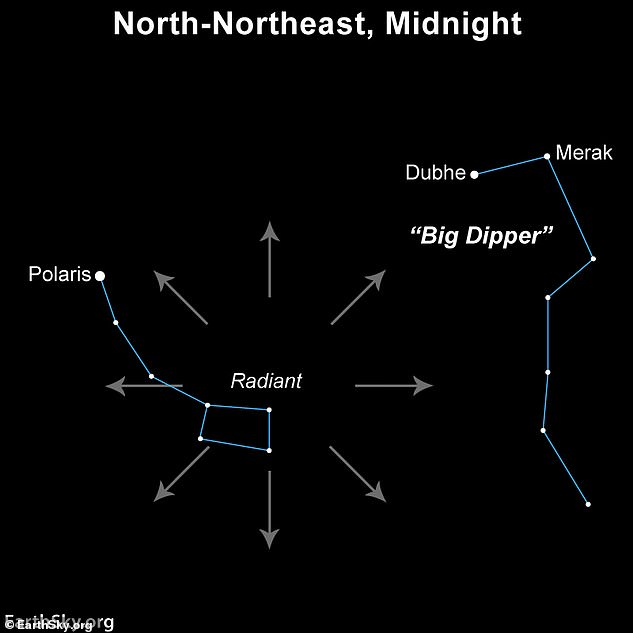
If you miss the International Space Station, you'll also have the chance to see the Ursid Meteor, which will peak on December 23 and appear to originate from the Ursa Minor constellation.
The Ursids period ranges from December 13 to 24 but reaches its peak in the early hours of December 23.
At its best, it can hit between five and 10 meteors per hour.
Unfortunately, the moon will be 85% full over the Christmas holiday, so bright light may interfere with viewing conditions.
On the other hand, if you find yourself opening up a telescope this Christmas morning, it creates some wonderful opportunities.
The bright moon is an ideal target for a novice astronomer to catch his eye.
You can also try to identify some lunar features like Copernicus Crater or Mare Tranquillitatis, also known as the Sea of Tranquility.
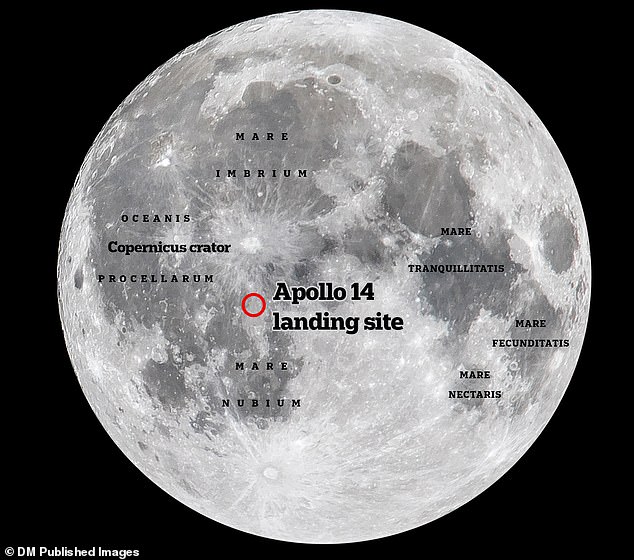
The moon will be 85% illuminated this weekend, so it will be a great opportunity to get a good view of some of the moon's features
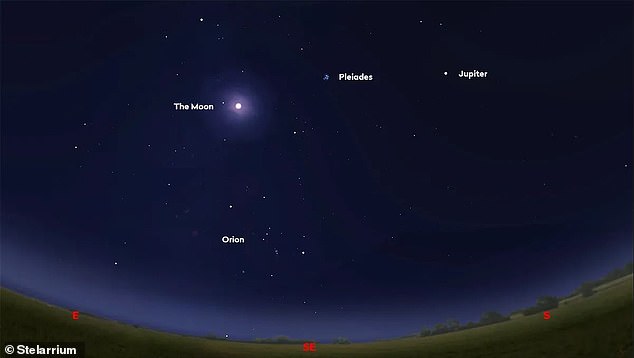
For more advanced stargazers, look right to the Moon to find the Pleiades and Jupiter star cluster this weekend which will both be visible to the naked eye.
If you're feeling extra ambitious, look to the right of the moon and you'll be able to see the Pleiades and Jupiter star cluster.
Even at lower magnification, the Pleiades star cluster is a fascinating sight.
While only seven of the brightest stars can be seen with the naked eye, a telescope will reveal countless bright stars.
Jupiter will appear as a bright star to the naked eye, but using a telescope, you may be able to see the Galilean moons, which will appear as small dark dots surrounding the planet.
So, whatever your skill level, there will be plenty of amazing sights to look out for over Christmas.
(Tags for translation)dailymail

